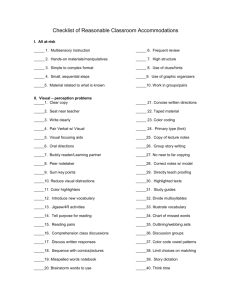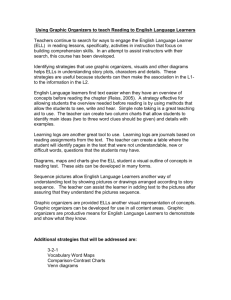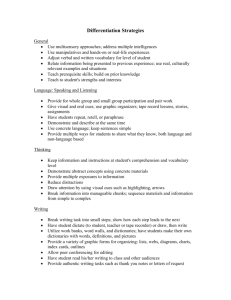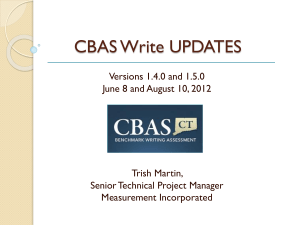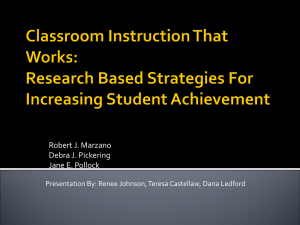Cues, Questions, Advance Organizers: Instructional Strategies
advertisement
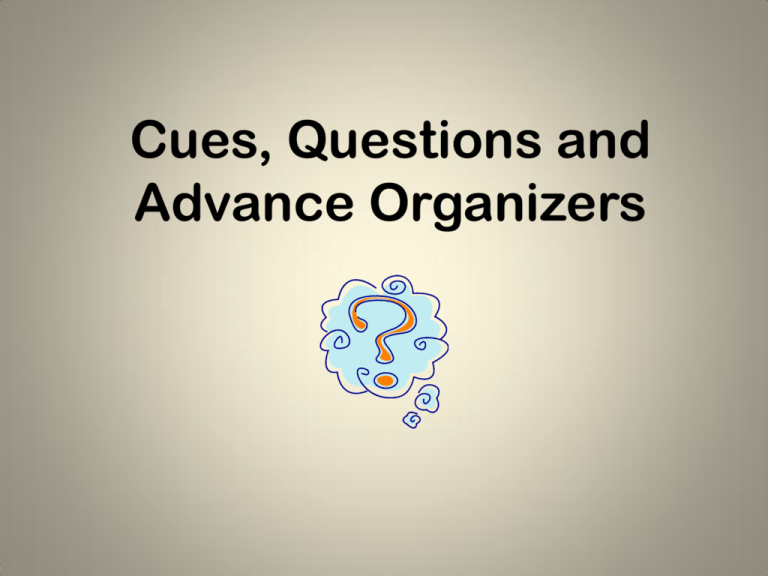
Cues, Questions and Advance Organizers High-Yield Instructional Strategies Using cues, questions, and advance organizers help students activate prior knowledge and deepen understanding of current learning. Cues and questions should focus on what is important instead of what student’s might find interesting. Advance organizers are organizational frameworks presented to students prior to teaching new content to prepare them for what they are about to learn. Advance organizers take the surprise out of what is to come, help students retrieve what they already know about a topic, and focus them on the new information. Cues & Questions Cues and questions are used to develop critical thinking and discussion before, during, and after the learning activity. They provide hints about upcoming lessons, reinforce prior knowledge, and provide new information. “Cue Tip” Use “Cue Sticks” to elicit student responses to higher-level questions. Students can also select a “Cue Stick” to create and answer a higherlevel question relating to the unit of study. “Cue Sticks” Inferential & Analytical Questions Teachers should provide students with ample practice answering inferential and analytical questions, since these are the types of questions that will appear on STAAR exams. Questions should also focus on what is important and should be aligned with the course TEKS. State standardized test questions often mirror the wording of the TEKS. Links: http://havefunteaching.com/worksheets/readingworksheets/inferences-worksheets/ http://www.havefunteaching.com/worksheets/graphic -organizers/predicting-outcomes/predict-and-infergraphic-organizer.pdf http://teacher.depaul.edu/resources/Inferential%20Q uestion%20Maker.pdf http://www.decd.sa.gov.au/northernadelaide/files/link s/readingshortstories.pdf http://www.decd.sa.gov.au/northernadelaide/pages/c omp/37986/?reFlag=1 http://www.curriculuminstitute.org/conferencearchives/handouts/CCSSO%20Que%20Questions.pdf http://www.bcps.org/offices/lis/models/tips/analyzing. htm http://www.tea.state.tx.us/student.assessment/staar/t estquestions/ http://reading.ecb.org/teacher/inferring/infer_lessonp lans.html http://eduscapes.com/sessions/pilot/pilotinference.ht m http://www.med.wright.edu/sites/default/files/aa/facd ev/_Files/PDFfiles/QuestionTemplates.pdf Advance Organizers Expository Advance Organizers explain new concepts and emphasize important content. Narrative Advance Organizers present information in story format and help set the objective for future lessons. Graphic Advance Organizers are used to activate prior knowledge, make predictions, organize information, stimulate thinking skills, and provide a visual framework for making connections to course content. Graphic Organizer Templates http://freeology.com/graphicorgs/ http://www.eduplace.com/graphicorganizer/ http://my.hrw.com/nsmedia/intgos/html/igo.htm http://www.educationoasis.com/curriculum/graphic_organize rs.htm http://its.leesummit.k12.mo.us/graphic_organizers.htm http://www.sanchezclass.com/reading-graphicorganizers.htm http://www.teach-nology.com/worksheets/graphic/ http://teacher.depaul.edu/Documents/Math Graphic Organizer Guide.pdf http://www.writedesignonline.com/organizers/ http://irondalecom.jefcoed.com/Documents/Graphic Organizers/organizer science.pdf http://havefunteaching.com/worksheets/graphic-organizers/ http://www.scholastic.com/teachers/lesson-plan/graphicorganizers-reading-comprehension http://www.everythingesl.net/inservices/graphic_organizers.p hp http://edhelper.com/teachers/graphic_organizers.htm http://books.heinemann.com/comprehending/graphicOrganiz ers.html http://www.vrml.k12.la.us/graphorgan/ http://www.vrml.k12.la.us/graphorgan/older/graphic_organize rs.htm http://www.greatsource.com/iwrite/students/s_expos_graph_ org.html More “Cue Tips” Cues should be explicit and focus on what is important. Higher-level questions produce deeper learning than lower-level questions. Keep “Cue Sticks” close by when teaching or writing up lesson plans. Waiting at least three seconds before accepting responses from students increases the depth of answers. Use collaborative groups to encourage thinking and sharing prior knowledge. Sharing personal knowledge and experiences promote interest in the content of upcoming lessons.
